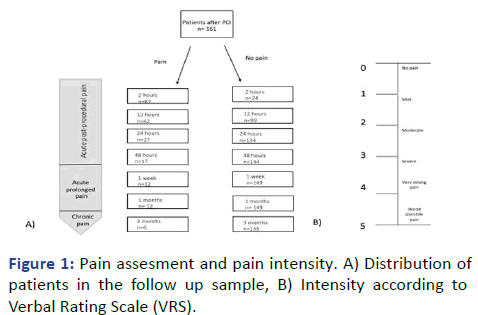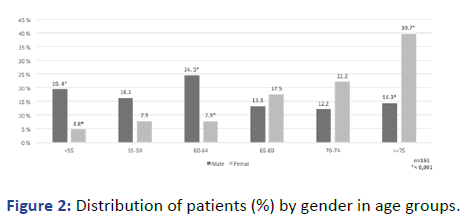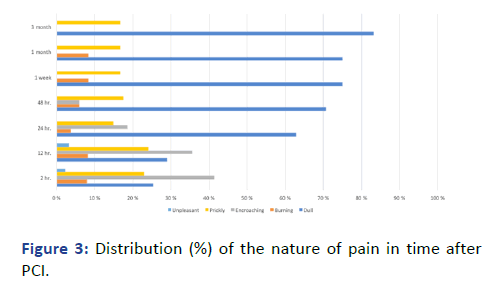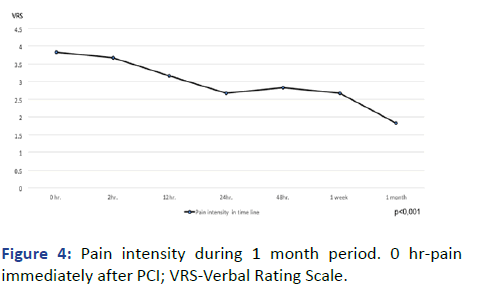Research Article - (2024) Volume 10, Issue 6
Prevalence of Pain and Access Complications Following Percutaneous Coronary Intervention via Radial Artery Access
L. Brogiene1,
G. Baksyte2,
A. Klimaite2*,
M. Paliokas1 and
A. Macas1
1Department of Anesthesiology, Lithuanian University of Health Sciences, Kaunas, Lithuania
2Department of Cardiology, Lithuanian University of Health Sciences, Kaunas, Lithuania
*Correspondence:
A. Klimaite, Department of Cardiology, Lithuanian University of Health Sciences, Kaunas,
Lithuania,
Email:
Received: 06-Dec-2019, Manuscript No. IPIC-24-3032;
Editor assigned: 11-Dec-2019, Pre QC No. IPIC-24-3032 (PQ);
Reviewed: 25-Dec-2019, QC No. IPIC-24-3032;
Revised: 21-Jun-2024, Manuscript No. IPIC-24-3032 (R);
Published:
19-Jul-2024
Abstract
Background: Post procedural pain is underestimated problem that usually is overlooked. In this study the focus is on prevalence of access-site pain and complications after Percutaneous Coronary Intervention (PCI) via radial artery access.
Material and methods: The data (demographic and periprocedural) of selected patients (n=161) 60.9% males and 39.1% females, who underwent elective PCI were collected prospectively and analysed in 2019. Verbal analogue scales were used to evaluate pain intensity after 2, 12, 24, 48 hours, 1 and 3 months after PCI.
Results: Access-site pain during the PCI procedure occurred in 29.8%. In 17.4% of cases moderate pain was persisting immediately after the procedure (p<0.05).
After 2, 12, 24, 48 hours pain was felt accordingly in 54%, 38.5%, 16.8%, 10.6% cases and it was moderate (p<0.05). 1 week and 1 month after the PCI procedure 7.5% of patients felt strong site pain. Chronic pain developed in 3.7% of patient and it was moderate. Compilations were arterial bleeding (9.3%), hematoma (26.7%), hand swelling (66.5%) and neuropathy (6.32%).
Conclusion: During 3-month period of time after PCI most patients experienced moderate pain. Despite that the access-site pain intensity was decreasing, post-procedural acute pain developed. Chronic pain developed in 3.7% of patients after PCI. Most common site complications were hematoma, arterial bleeding and hand swelling.
Keywords
Percutaneous coronary intervention; Acute pain; Chronic pain; Radial artery
Introduction
The most common method used to diagnose and
treat diseases caused by coronary arteries pathology is Percutaneous Coronary Intervention (PCI), because of it’s
relatively easy and fast performance, short patient’s recovery
time, immediate treatment effect and early patient’s
mobilization after procedure. Today, the method of first choice for PCI is Trans-Radial (TR) approach, because of lower
risk of complications related to puncture site comparing with
Trans-Femoral (TF) approach. In spite of PCI benefit to the
patient and it’s conducting security this procedure can also
cause negative outcomes, which are rare but can cause
debilitating conditions. The present studies describing these
possible complications: Acute artery spasm, thrombosis,
occlusion, difficult to controlled arterial bleeding (this can
cause formation of hematoma, it’s spreading, also
compartment syndrome), pseudoaneurysm, arteriovenous
fistula, nerve damage or infection, which rate of
manifestation, according to literature sources, varies.
There is still lack of information about other conditions after
this procedure. One of them is access-site pain syndrome
after PCI. Post-procedural pain can occur after any procedure
that causes actual or potential tissue damage and individuals
who undergo potentially painful procedures must have
optimal pain management before, during and after the
procedure.
However, recently presents a growing number of clinical cases
describing precisely debilitating pain syndromes as complex
regional syndrome and some studies that describes
prevalence of acute pain after PCI at intervention site. Acute
post-procedural arm pain occurs approximately in 1 out of 20
patients after PCI via trans-radial approach. Several studies
reported severe peri-procedural pain with prevalence of
4.49%-9.57%.
Chronic pain development after the procedure in literature
described as rare condition and its prevalence is low.
Important thing is that this rare state is very disturbing
patient’s everyday life with restriction of ability to work and it
is hard to treat.
Post procedural pain and its management is underestimated
problem that usually overlooked. Our aim is to focus on
prevalence of access-site pain and complications after PCI via radial artery access [1].
Materials and Methods
This is a prospective observational longitudinal study. The
data collected of patients, who underwent elective PCI
procedure using trans-radial access in hospital of Lithuanian
university of health sciences department of cardiology and
analysed in 2019. All patients were informed properly and
gave their written consent to participate in our study, which
protocol was approved by the local institutional bioethics
committee (protocol number BEC-MF-328). Primer outcome is
to identify acute and chronic pain prevalence and
complications and second outcome observe assessment and
management of the pain (pain relieve medication given/not
given) after PCI procedure via radial artery access.
Patients (n=161) who underwent scheduled PCI procedure
were included and followed up them for 3 months. The
demographic (patients age, gender, body mass index >25,
anxiety (yes/no) before procedure, smoking, arterial
hypertension, diabetes mellitus, dyslipidaemia, depression, rheumatoid arthritis, carpal tunnel syndrome and other
comorbidities) and peri-procedural (intervention duration,
changing location of intervention during procedure, arterial
bleeding from puncture site, hand swelling, intervention
wound pressure time after PCI, hematoma in puncture site,
pseudoaneurysm, arterial thrombosis, arteriovenous fistula,
neuropathy, intervention site infection, pain before, during
and after the procedure) data were collected prospectively.
Patients with limitation of self-expression or having
emergency PCI procedure, a severe psychiatric illness or <18
years old patients were excluded.
Pain Assessment
Patients were asked about paint appearance at the
intervention site after PCI. For each patient who presented
with pain evaluation questions were assessed (pain location,
spreading, nature, intensity, occurrence circumstances,
reducing/increasing factors, accompanying signs) [2]. Patients
evaluated their pain nature by choosing one of these provided
options: Dull, burning, prickling, tight, uncomfortable. Pain
manifestation and duration time was divided in three groups:
Acute post-procedural pain (pain occurred during first 48
hours after PCI), acute prolonged pain (patients felt pain more
than 48 hours, but less than 3 months after PCI), chronic pain
(pain lasted more than 3 months after PCI). Pain intensity was
evaluated according to Verbal Rating Scale (VRS): No pain-0,
mild-1, moderate-2, severe-3, very severe-4 and worst
possible pain-5 after 2, 12, 24 and 48 hours in hospital settings
and they were interviewed after 1 week, 1 and 3 months after
PCI when they were discharged (Figure 1). Patients were
followed for other manifested complications (bleeding from
puncture site, hematoma, etc.). We contacted with each
patient personally by telephone after 1 week, 1 and 3 months
after PCI. Pain management was recorded from the medical
notes and during the interview after discharge from the
hospital.

Figure 1: Pain assesment and pain intensity. A) Distribution of
patients in the follow up sample, B) Intensity according to
Verbal Rating Scale (VRS).
PCI Procedure and Haemostasis
Access method, sheath size, shape of guiding catheter,
medical therapy, other materials are left to the discretion of
the operator. During our research PCI was provided by
performing catheterization through radial artery of the right
or left hand. When TR method was used, the first step before puncture was to find the needed artery by anatomical
orientations and palpation. Before providing PCI, local
aesthetic medicament is being injected underneath the skin
(lidocaine solution 0.5 ml-1 ml, 1%) the operator would
puncture the radial artery with the introducer needle through
the Seldinger technique [3]. Haemostasis was provided by
applying pressing bandage on the wrist on the puncture site
and it was keeping tight after intervention for 17.98 (± 6.16)
hours. It should be noted that the bandage was started to
release after 4 hours and continuous releasing, until it was
safe to remove it completely.
Pain Management
Pain medication was given as needed by the ward medical
staff and was recorded in drug chart.
Statistical analysis: Data analysis was performed with SPSS
statistical software (v. 20.0 IBM). Normally distributed
continuous variables were presented as mean ± SD and
univariately compared using student t test. When the
distribution is not normal, median along with first (Q25) and
third quartiles (Q75) were presented and the groups were
compared using a Wilcoxon rank sum test. Categorical data
was presented as frequency and percentage and were
statistically tested using the chi-square test or the Fisher’s
test, Mann-Whitney where appropriate. Missing data points
were not imputed. All differences were considered
statistically significant at a p less than 0.05.
Results
In the study 60.9% males (n=98) and 39.1% females (n=62)
were enrolled. Patients mean age was 66.23 (± 10.59) years
and there was significant difference found between males
63.13 (± 10.24 yrs.) and females 71.05 (± 9.32 yrs.), p<0.001.
In age groups <55 and 60-64 years PCI was performed more in
males than females and in ≥ 75 years group more in females
than males (Figure 2).

Figure 2: Distribution of patients (%) by gender in age groups.
Patient’s demographic and clinical data is showed in the Table
1. There was found no difference between gender and age
groups according to comorbidities, body mass index [4]. All
patients had history of ischemic heart disease and the median
was 7 (2-15) years.
| Variable |
No. (%) of patients (n=161) |
| Gender (female/male) |
63 (39.1)/98 (60.9) |
| Mean (range) age (years) |
66.23 (± 10.59) |
| Diabetes mellitus |
27 (16.8) |
| Smoking (female/male) |
4 (6.3)/46 (46,9)✣ |
| Dyslipidemia |
92 (57.1) |
| Arterial hypertension |
127 (78,9) |
| Tunnel carpal syndrome before procedure |
5 (3.1) |
| Median of IHD (years) |
7 (2-15) |
| Depression |
2(1.2) |
| Rheumatoid arthritis |
4(2.5) |
| Body mass index (kg) |
28.62 (± 4.77) |
| Median duration of the procedure (minutes) |
25 (20-40) |
| Mean time of the bandage removal (hours) |
17.98 (± 6.16) |
| First time preformed PCI |
96 (59.6) |
| Anxiety before the procedure (female/male) |
19 (11.8)/16 (9.9)✣ |
| Pain before the procedure in puncture site |
5 (3.1) |
Note: *Except otherwise indicated ✣ p<0,001
Table 1: Patient demographics and clinical data.
Access-site complication after PCI established in 28.6% (n=46)
of patients (Table 2). Hematoma occurred in 26.7% (n=43) of cases and statistically more in females then males accordingly
14.9% (n=24) vs. 11.8% (n=19).
| Variable |
No.(%) of patients (n=161) |
| Arterial bleeding |
15 (9.3) |
| Hematoma |
43 (26.7) |
| Neuropathy (objective findings) |
10 (6.2) |
| Hand swelling |
107 (66.5) |
| Changing location of intervention during procedure |
5 (3.1) |
Table 2: Access-site complications after procedure.
According to medical records, post-procedural pain
management (pain relieve) was performed only, when
patients were self-referring about the pain to ward medical
staff. There is no post-procedural pain assessment and
management protocol on the ward. In all cases pain
management started with non-steroidal drugs (ketoprofen
intravenous or intramuscular) [5]. If it was not helping to
reduce the pain, strong opioids as morphine were chosen.
Access-site pain during the PCI procedure occurred in 29.8%
(n=48) of patients. For 2.5% (n=3) pain medication (strong
opioid) were given (p<0.01). Immediately after the procedure
28.6% (n=46) of patients felt moderate pain (median 2 (2-3))
which was dull (35%), burning (10%) and prickly (28%). 12.4%
(n=20) patients who felt pain during the procedure had no
pain immediately after the procedure, but in 17.4% (n=28) of
cases continuous moderate pain was found (p<0,001).
After 2 hours moderate pain (median 2 (2-4)) was felt in 54%
(n=87) of patients which was mostly encroaching (41%),
dull (25%) and prickly (23%) by nature (Figure 3). For 5.7%
(n=8) of patients’ pain medication (non steroids, antiinflammatory)
were given and in 62.5% (n=5) of cases
they relieved the access-site pain.

Figure 3: Distribution (%) of the nature of pain in time after
PCI.
After 12 hours moderate pain (median 2 (1-2)) was felt in
38.5% (n=62) of patients. To 11.2% (n=7) patients were given
pain medication and in 85.7% (n=6) of cases pain was relieved. Pain by nature was mostly encroaching (35.5%), dull
(29%) and prickly (24.2%).
After 24 hours pain was felt in 16.8% (n=27) of patients and
intensity was moderate (median 2 (1-3)). Four patients
(14.8%) get pain medication (anti-inflammatory, strong
opoids) and in 50% (n=2) it helped to relieve the pain. 48h
after 10.6% (n=17) patients was in pain, intensity was
moderate (median 2 (1-4)); 23% (n=4) received pain
medication (anti-inflammatory) and in 75% of cases it was
effective. 1 week after the PCI pain occurred in 7.5% (n=12) of
cases and intensity was strong site (median 3 (1-4)). For 41%
(n=5) pain medication was given and in 80% (n=4) of cases it
helped. 1 month after the PCI procedure 7.5% (n=12) of
patients felt pain and it was moderate intensity pain (median
2 (1-2)). For 16.6% (n=2) pain medication was given and in
50% (n=1) of cases it was effective.
During the 1-month period access-site pain intensity (Figure
4) statistically significantly was decreasing, despite that,
chronic pain developed in 3.7% (n=6) of patients and it was
mild-moderate by intensity (median 1.5 (1-3)) and dull
(83.3%) or prickly (16.7%) by nature [6]. Only one patient
reported, that he was prescribed pain medication (antiinflammatory)
and it was effective.

Figure 4: Pain intensity during 1 month period. 0 hr-pain
immediately after PCI; VRS-Verbal Rating Scale.
Discussion
Ischemic Heart Disease (IHD) is widespread life-threatening
condition and in women develops 10 years later compare with
men. In our study we have more males than females, but
distribution in age group is different. In age group >65 years,
we have more female than males who undergo PCI procedure.
We observed that first time PCI procedure was performed in
59.6% patients and statistically more in females than males. In
literature we can find gender differences regards IHD and that
more attention is given to male patients. Recent studies
summarized, that risk factors of IHD in women is
underestimated. Women are less likely to be referred for
functional testing for IHD, there are lower rate of diagnostic
PCI performed.
Radial access highly reduced vascular complications compare
with femoral access. However, radial access can be associated
with complications such as hematoma, pseudoaneurysm,
artery occlusion or spasm [7]. In the same time, we have
studies coming up, that describing upper extremity
disfunction with prevalence up to 9.6%.
Cheng, et al., reported that female gender associated with
higher presence of bleeding during haemostasis and
ecchymosis. Complications in our study was arterial bleeding,
hematoma, neuropathy and swelling. We found no difference
between females and males in hand swelling onset, but
significantly more women developed hematomas after PCI
compared with men. These results show that medical staff
should pay more attention to female gender in order to avoid
access-site complications.
In literature, higher pain sensitivity observed in females than
males and population-based studies show bigger pain
prevalence among women relative to men either. These
findings are explained by the biological and psychosocial
mechanisms. However, results from post-procedural or postsurgical
pain studies in gender differences varies and they are
contradictory. Some studies indicate a higher pain intensity
among men’s, other among women’s population. In our study
there was no differences among gender according to pain
intensity or pain prevalence, while male percentage was
higher compare to female [8]. Notable, that females in our
study felt more anxiety compare to males. In most literature
anxiety is identified as a risk factor for acute pain
development after surgery.
Acute pain is caused by injury, surgery, illness, trauma or
medical procedures lasting for short period of time and
disappears when the underlying cause is healed. Access-site
pain after PCI mostly can be caused by vascular complications
(ischemia, thrombosis, spasm), direct or indirect nerve
damage, post-procedural site pain care (haemostasis).
Prolonged or inappropriate compression at the puncture site
of radial artery may result in damage or injury of radial
sensory nerve, causing the pain or hand dysfunction. Radial
compression may result in blood flow reduction into the
surrounding tissues such as muscles. Studies shows how
lactate released from ischemic muscle may cause ischemic
pain by acting sensory neurons that innervates muscles [9].
Dharma, et al., in the retrospective study concluded that the
prevalence of site pain is 4.5%. Pain was evaluated 1 day after
procedure and authors highlighted, that initial data collection
was not set to collect all the data that might interact with
forearm pain.
In other study from Cheng Ka Yen, et al., post procedure pain
was evaluated after 3 and 24 hours. They found that pain
intensity after 3 hours was 0-71 (range 0-100) and the median
was 9. After 24 hours pain intensity was decreasing 0-40
(range 0-100), but more than 50% of patients were in pain
[10].
We find that acute pain prevalence during the time period
was changing, highest point was during 12 hours after that it
was decreasing, but the intensity remained moderate
according to VRS. The nature of pain was dull, prickly, burning
and encroaching and only 3.2% during 12 hours after
procedure felt discomfort or unpleasant feeling rather than
pain [11].
In 24-48 hours, patient still had pain and the prevalence was
up to 16%. The pain intensity was moderate and by nature
dull, encroaching or prickly. The nature of pain showing that
nociceptive and neuropathic mechanisms can be involved in
the pain process. But more detailed studies are needed [12].
In several clinical cases was reported complex regional
syndrome, debilitating condition, which can lead to chronic
pain state. Chronic pain is defined as continuous, long-term
pain lasting more than 12 weeks or after the time that healing
would have been expected. In literature chronic pain after PCI
it is very rare condition, but exceptionally disturbing patient's
daily life and restricting patient’s ability to work.
Our study shows 3.7% prevalence of chronic pain after PCI
procedure. The most important is to prevent this debilitating
condition that can be hard to treat. We know from chronic
post-surgical pain studies, that one of the main clinical factors,
which is important in prediction of persisted pain
development are intensity of acute postoperative pain and
percentage of time spent in severe pain [13].
The recognition and good management of acute pain state
after PCI procedure is essential. Our study showed, acute
postprocedural pain has high prevalence and stay up to one
month. Pain medication was given only if patient had
complained about pain (self-reported). There is no postprocedural
pain management protocol. It can be associated
with doctors believes about pain after this particular
procedure and cultural issues. Most Lithuanians tend to
withhold anxiety, depression or pain. There is spread thinking
that after procedure or surgery there should be pain and, in
most cases, they will refer pain only if it would be severe.
There is a lack of literature and randomized studies
assessment and management in topic of post-procedural pain
after PCI, especially in complex patients, who has
comorbidities and pain management strategy in acute or
chronic pain state in patients with IHD or heart failure can be
difficult [14].
Different studies report different risk factors for postprocedural
pain and most of them are for acute pain after PCI.
Those risk factors are low BMI, small wrist, female gender,
haemostasis, radial artery occlusion, hematoma, number of
access attempts.
Main focus should be on identification of risk factors, which
would help to prevent acute and chronic pain after PCI
manifestation in the future and will help to create postprocedural
pain management protocol or guideline. Limitation
is that this study is observational, performed in single centre
with small size sample, specific compression devices and were
individually applied and not regulated by the researchers [15].
However, it is important to have wider knowledge about
acute and chronic post-procedural pain development and
management after PCI and further research on assessment,
management, risk factors identification is needed.
Conclusion
Our study is demonstrating that most of the patients
experienced acute post-procedural and acute prolonged pain
with moderate intensity after PCI. Despite that the access-site
pain intensity was decreasing during 3-month period, postprocedural
chronic pain developed in 3.7% of cases. Most
common site complications were hematoma, arterial bleeding
and hand swelling.
Acknowledgement
We would like to thank Lithuanian University of Health
Science, Department of Cardiology for allowing research data
collection.
Authors Contributions
L. Brogiene designed the research; M. Paliokas and A. Klimaite
performed the research; L. Brogiene, M. Paliokas, A. Klimaite
analysed the data and wrote the manuscript; G. Baksyte and
A. Macas revised the research and made the final approval.
Disclosure
There were no conflicts of interest in this work.
References
- Cho EJ, Yang JH, Song YB (2013) Type II complex regional pain syndrome of the hand resulting from repeated arterial punctures during transradial coronary intervention. Catheter Cardiovasc Interv. 82(4):465-468.
[Crossref] [Google Scholar] [PubMed]
- Bazemore E (2005) Problems and complications of the transradial approach for coronary interventions: A review. J Invasive Cardiol. 17(3):156-159.
[Google Scholar] [PubMed]
- Shroff A, Siddiqui S, Burg A, Singla I (2013) Identification and management of complications of transradial procedures. Curr Cardiol Rep. 15(4):350.
[Crossref] [Google Scholar] [PubMed]
- Kanei Y, Kwan T, Nakra NC, Liou M, Huang Y, et al. (2011) Transradial cardiac catheterization: A review of access site complications. Catheter Cardiovasc Interv. 78(6):840-846.
[Crossref] [Google Scholar] [PubMed]
- Czarnecki ML, Turner HN, Collins PM, Doellman D, Wrona S, et al. (2011) Procedural pain management: A position statement with clinical practice recommendations. Pain Manag Nurs. 12(2):95-111.
[Crossref] [Google Scholar] [PubMed]
- Papadimos TJ, Hofmann JP (2002) Radial artery thrombosis, palmar arch systolic blood velocities and chronic regional pain syndrome 1 following transradial cardiac catheterization. Catheter Cardiovasc Interv. 57(4):537-540.
[Crossref] [Google Scholar] [PubMed]
- Sasano N, Tsuda T, Sasano H, Ito S, Sobue K, et al. (2004) A case of complex regional pain syndrome type II after transradial coronary intervention. J Anesth. 18(4):310-312.
[Crossref] [Google Scholar] [PubMed]
- Dharma S, Kedev S, Patel T, Gilchrist IC, Rao SV (2019) The predictors of post-procedural arm pain after transradial approach in 1706 patients underwent transradial catheterization. Cardiovasc Revasc Med. 20(8):674-677.
[Crossref] [Google Scholar] [PubMed]
- Zwaan EM, Koopman AG, Holtzer CA, Zijlstra F, Ritt MJ, et al. (2015) Revealing the impact of local access-site complications and upper extremity dysfunction post transradial percutaneous coronary procedures. Neth Heart J. 23(11):514-524.
[Crossref] [Google Scholar] [PubMed]
- Benit E, Missault L, Eeman T, Carlier M, Muyldermans L, et al. (1997) Brachial, radial or femoral approach for elective Palmaz‐Schatz stent implantation: A randomized comparison. Cathet Cardiovasc Diagn. 41(2):124-130.
[Crossref] [Google Scholar] [PubMed]
- Hildick‐Smith DJ, Walsh JT, Lowe MD, Shapiro LM, Petch MC (2004) Transradial coronary angiography in patients with contraindications to the femoral approach: An analysis of 500 cases. Catheter Cardiovasc Interv. 61(1):60-66.
[Crossref] [Google Scholar] [PubMed]
- Tharmaratnam D, Webber S, Owens P (2010) Adverse local reactions to the use of hydrophilic sheaths for radial artery canulation. Int J Cardiol. 142(3):296-268.
[Crossref] [Google Scholar] [PubMed]
- Ahmed WH (2003) Transradial coronary angiography and intervention. Saudi Med J. 24(8):850-853.
[Google Scholar] [PubMed]
- Sciahbasi A, Fischetti D, Picciolo A, Patrizi R, Sperduti I, et al. (2009) Transradial access compared with femoral puncture closure devices in percutaneous coronary procedures. Int J Cardiol. 137(3):199-205.
[Crossref] [Google Scholar] [PubMed]
- Jang HJ, Kim JY, Han JD, Lee HJ, Kim JS, et al. (2016) Numbness after transradial cardiac catheterization: The results from a nerve conduction study of the superficial radial nerve. Korean Circ J. 46(2):161-168.
[Crossref] [Google Scholar] [PubMed]
Citation: Brogiene L, Baksyte G, Klimaite A, Paliokas M, Macas A (2024) Prevalence of Pain and Access Complications
Following Percutaneous Coronary Intervention via Radial Artery Access. Interv Cardiol J. 10:51.
Copyright: © 2024 Brogiene L, et al. This is an open-access article distributed under the terms of the Creative Commons
Attribution License, which permits unrestricted use, distribution, and reproduction in any medium, provided the original author
and source are credited.





